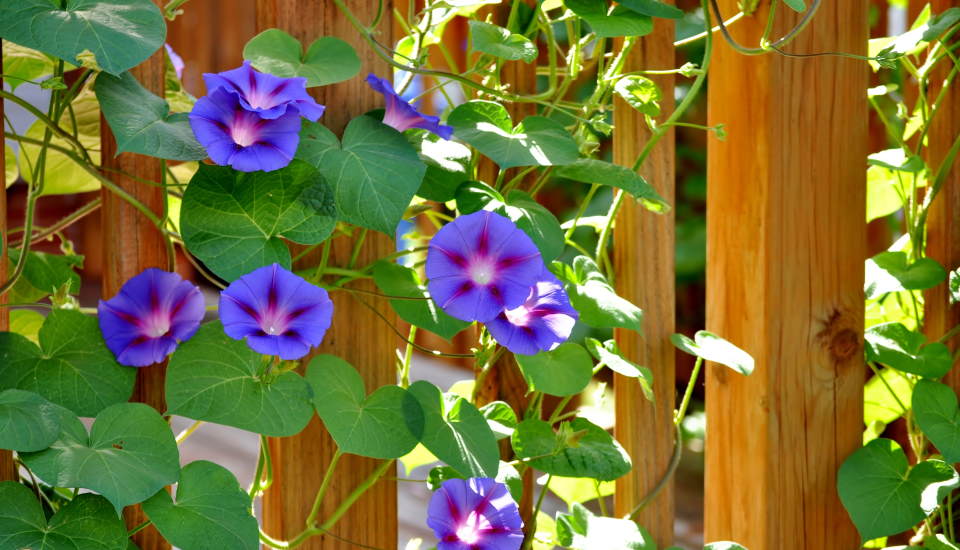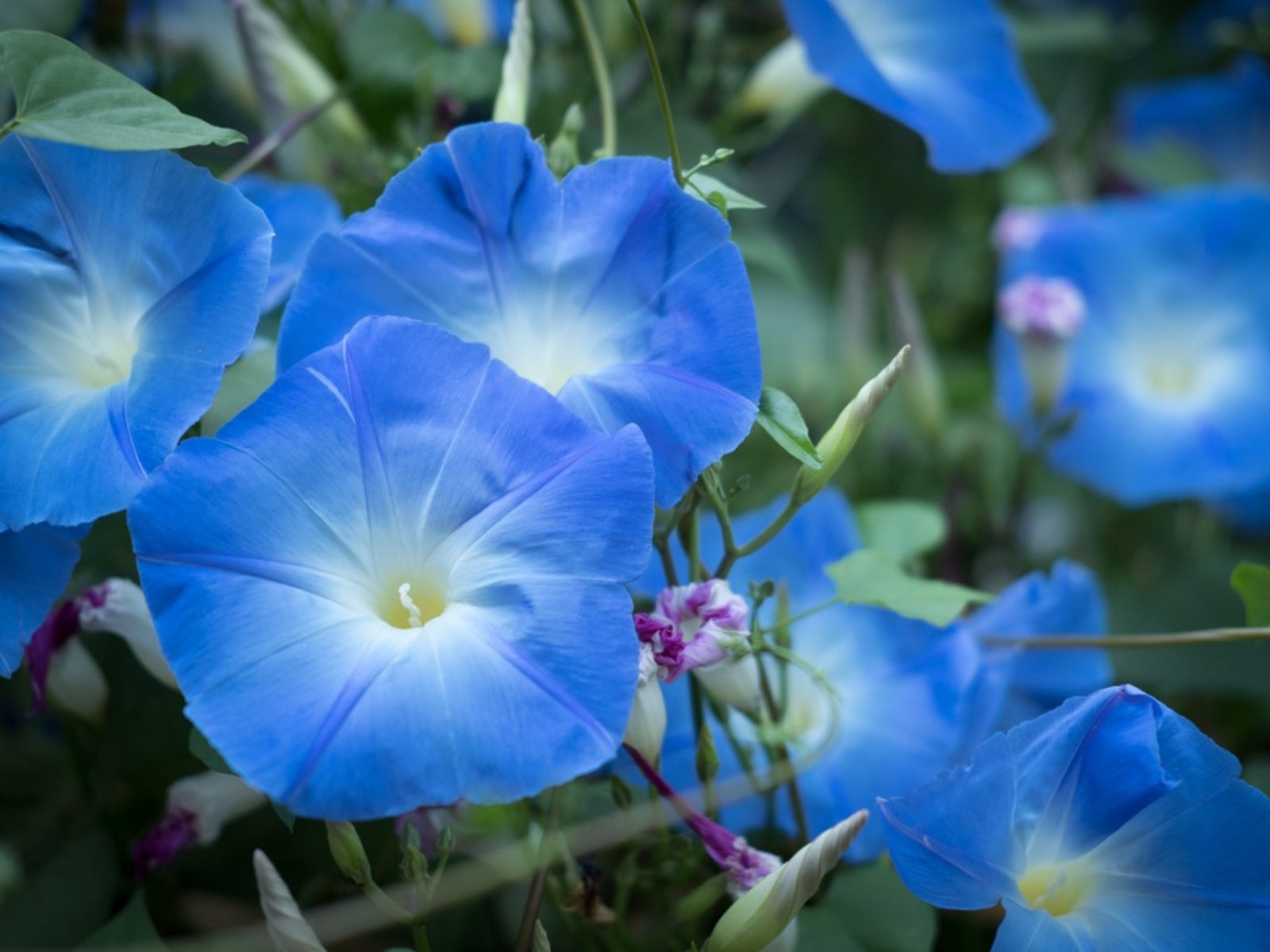Understanding the Life Cycle of Morning Glories
Morning glories, with their trumpet-shaped flowers and heart-shaped leaves, are a popular annual vine in many gardens. Native to tropical and subtropical regions of the Americas, these plants have been cultivated for centuries for their beauty and medicinal properties. To appreciate the blooming habits of morning glories, it’s essential to understand their life cycle, which consists of three primary stages: growth, flowering, and seed production.
The growth stage begins when morning glory seeds germinate, typically in late spring or early summer, depending on the region and climate. During this stage, the seedlings develop their root system, stems, and leaves. As the plants grow, they begin to twine around nearby structures, such as trellises or fences, using their tendrils to climb.
As the morning glories mature, they enter the flowering stage, which is the most anticipated part of their life cycle. The flowers, typically blue, purple, pink, or white, bloom in the morning and wilt by the evening, hence the name “morning glory.” This stage usually occurs in mid to late summer, although the exact timing depends on factors like weather, soil quality, and the specific variety of morning glory. Many gardeners wonder when do morning glory bloom, and the answer lies in understanding the plant’s life cycle.
After the flowers have bloomed, the plants enter the seed production stage. The wilted flowers give way to seed pods, which contain several seeds each. As the seeds mature, the pods dry and split open, dispersing the seeds for the next generation. This stage marks the end of the morning glory’s life cycle, as the plants typically die off with the first frost.
How to Encourage Morning Glory Blooms in Your Garden
To encourage morning glories to bloom in your garden, it’s essential to create an ideal environment that meets their needs. By providing the right conditions, you can enjoy a profusion of colorful flowers and extend the blooming period. Here are some tips and tricks to help you create a morning glory haven:
Soil Preparation: Morning glories thrive in well-draining soil with a pH between 6.0 and 7.0. Add organic matter like compost or manure to improve soil fertility and drainage. If your soil is heavy clay or sandy, mix in some organic matter to achieve a balanced texture.
Sunlight: Morning glories require full sun to partial shade, depending on the variety. Ensure your plants receive at least 6 hours of direct sunlight per day. If you live in a hot climate, provide some afternoon shade to prevent scorching.
Watering: Morning glories need consistent moisture, especially when they’re producing flowers. Water them deeply once or twice a week, depending on weather conditions. Avoid overwatering, which can lead to root rot and other problems.
Fertilization: Feed your morning glories with a balanced fertilizer (10-10-10) once a month. You can also use a high-phosphorus fertilizer (10-20-10) to promote blooming. Avoid overfertilizing, as this can damage the plants.
Support: Morning glories are climbing plants and need something to twine around. Provide a trellis, fence, or other support for them to climb. This will help keep the plants upright and encourage more blooms.
By following these tips, you can create an ideal environment for your morning glories to thrive and bloom profusely. Remember, when do morning glory bloom is largely dependent on the care and attention you provide. With a little effort, you can enjoy a stunning display of morning glory flowers in your garden.
The Role of Weather and Climate in Morning Glory Blooms
Weather and climate play a significant role in the blooming habits of morning glories. Temperature, humidity, and precipitation can all impact the timing and duration of morning glory blooms. Understanding how these factors affect morning glories can help you optimize their growing conditions and encourage more blooms.
Temperature: Morning glories thrive in temperatures between 65°F and 85°F (18°C and 30°C). When temperatures drop below 60°F (15°C), blooming slows down, and when they rise above 90°F (32°C), the plants can become stressed. In regions with extreme temperature fluctuations, morning glories may bloom earlier or later than expected.
Humidity: Morning glories prefer a relatively high humidity, typically above 50%. In dry climates, morning glories may require more frequent watering to maintain optimal humidity levels. When humidity is too low, the plants may drop their buds or fail to bloom.
Precipitation: Morning glories need consistent moisture, especially when they’re producing flowers. Adequate rainfall or irrigation can encourage more blooms, while drought can lead to fewer or no blooms. In regions with heavy rainfall, morning glories may bloom more profusely, while in areas with low rainfall, they may bloom less frequently.
Regional Climate Variations: Morning glories bloom at different times in different regions, depending on the local climate. In the Northern Hemisphere, morning glories typically bloom in mid to late summer, while in the Southern Hemisphere, they bloom in mid to late winter. In regions with mild winters, morning glories may bloom year-round. When do morning glory bloom in your region? Understanding the local climate and weather patterns can help you anticipate and prepare for the blooming season.
By understanding the impact of weather and climate on morning glory blooms, you can create an optimal environment for your plants to thrive. By providing the right conditions, you can encourage more blooms and enjoy a longer blooming period. Remember, the key to successful morning glory cultivation lies in understanding the intricacies of their growth habits and adapting to local climate conditions.
When to Expect Morning Glory Blooms in Different Regions
Morning glories are known for their vibrant, trumpet-shaped flowers that bloom in a variety of colors, including blue, purple, pink, and white. But when do morning glory bloom? The answer depends on the region, climate, and specific variety of morning glory. In general, morning glories bloom in the late summer to early fall, but the exact timing can vary significantly depending on where you live.
In the Northern Hemisphere, morning glories typically bloom from mid-summer to early fall, around July or August. In regions with a longer growing season, such as the Southern United States, morning glories may bloom as early as June or as late as October. In areas with a shorter growing season, such as the Northern United States or Canada, morning glories may not bloom until late August or early September.
In the Southern Hemisphere, where the seasons are reversed, morning glories typically bloom from November to February. In regions with a mild winter, such as parts of Australia or South Africa, morning glories may bloom year-round.
It’s also important to note that different varieties of morning glories have different blooming periods. Some varieties, such as the ‘Heavenly Blue’ morning glory, bloom for a shorter period of time, typically around 6-8 weeks. Other varieties, such as the ‘Grandpa Ott’ morning glory, can bloom for several months.
When do morning glory bloom in your region? The best way to determine this is to check with local nurseries, gardening clubs, or online resources specific to your region. By understanding when morning glories typically bloom in your area, you can plan your garden accordingly and enjoy these beautiful flowers for as long as possible.
The Importance of Deadheading for Prolonged Blooming
Deadheading is a simple yet effective technique that can encourage prolonged blooming in morning glories. By removing spent flowers, you can redirect the plant’s energy from seed production to producing more blooms. This process not only extends the blooming period but also improves the overall appearance of the plant.
To deadhead morning glories, start by inspecting the plant regularly for spent flowers. Gently grasp the faded bloom between your thumb and index finger, and twist it off at the base of the stem. Make sure to remove the entire flower, including the seed pod, to prevent the plant from going to seed.
It’s essential to deadhead morning glories regularly, as allowing the plant to produce seeds can reduce flowering. By removing spent blooms, you can encourage the plant to produce more flowers, resulting in a longer blooming period. Additionally, deadheading can help maintain the plant’s shape and promote bushy growth.
When deadheading morning glories, it’s also important to consider the timing. Remove spent flowers in the morning, after the dew has dried but before the heat of the day. This helps prevent moisture from collecting on the plant and reduces the risk of fungal diseases.
By incorporating deadheading into your morning glory care routine, you can enjoy a longer and more vibrant blooming period. This simple technique can make a significant difference in the appearance of your garden, and it’s a great way to encourage morning glories to bloom for weeks to come.
Common Mistakes to Avoid When Growing Morning Glories
While morning glories are relatively easy to grow, there are some common mistakes that can prevent them from blooming. By being aware of these mistakes, you can take steps to avoid them and ensure that your morning glories thrive.
One of the most common mistakes is overwatering. Morning glories prefer well-draining soil and can be susceptible to root rot if the soil is too wet. Check the soil regularly and only water when it feels dry to the touch. On the other hand, underwatering can also prevent morning glories from blooming. Make sure to provide consistent moisture, especially during hot weather.
Inadequate support is another mistake to avoid. Morning glories are climbing plants and need something to climb on. Provide a trellis or other support for the vines to climb, and make sure it’s sturdy enough to hold the weight of the plant.
Insufficient sunlight can also prevent morning glories from blooming. These plants require full sun to partial shade, so make sure to plant them in a location that receives at least six hours of direct sunlight per day.
Failing to fertilize can also impact blooming. Morning glories are heavy feeders and benefit from regular fertilization. Use a balanced fertilizer and follow the instructions on the package for application rates.
Finally, neglecting to deadhead can prevent morning glories from blooming. Remove spent flowers regularly to encourage the plant to produce more blooms. This simple step can make a big difference in the number of flowers you get.
By avoiding these common mistakes, you can create an ideal environment for your morning glories to thrive. With proper care and attention, you can enjoy a profusion of blooms and add beauty and color to your garden.
Choosing the Right Morning Glory Variety for Your Garden
With over 1,000 species of morning glories, choosing the right variety for your garden can be overwhelming. However, by understanding the unique characteristics, growth habits, and blooming periods of different varieties, you can select the best one for your specific climate and garden conditions.
One of the most popular varieties is the ‘Heavenly Blue’ morning glory, which produces vibrant blue flowers with a yellow center. This variety is known for its rapid growth and profuse blooming, making it a great choice for trellises or arbors.
The ‘Grandpa Ott’ morning glory is another popular variety, known for its bright purple flowers with a pink center. This variety is a bit more compact than the ‘Heavenly Blue’, making it a great choice for smaller gardens or containers.
If you’re looking for a variety that blooms in the fall, the ‘Moonflower’ morning glory is a great choice. This variety produces large, white flowers that bloom in the evening and remain open until the morning, hence its name.
Some morning glory varieties are specifically bred for their unique foliage, such as the ‘Split-Second’ variety, which has leaves with a unique, split shape. This variety is a great choice for adding interest to your garden even when the plants are not in bloom.
When selecting a morning glory variety, consider factors such as climate, soil type, and amount of sunlight your garden receives. By choosing a variety that is well-suited to your garden conditions, you can ensure that your morning glories will thrive and provide a profusion of blooms throughout the growing season.
Remember, when do morning glory bloom? The answer depends on the variety and your location. In general, morning glories bloom in the summer months, but some varieties can bloom in the spring or fall. By choosing the right variety for your garden, you can enjoy a longer blooming period and add beauty and color to your outdoor space.
Tips for Extending the Blooming Period of Morning Glories
While morning glories are known for their profuse blooming, there are several tips and techniques you can use to extend the blooming period and keep your plants producing flowers for as long as possible.
One of the most effective ways to extend the blooming period is through pruning. By pruning your morning glories regularly, you can encourage the plant to produce more flowers and prevent it from going to seed. Simply cut back the vines to about 6 inches from the ground, and the plant will respond by producing new growth and more flowers.
Fertilization is another key factor in extending the blooming period. Morning glories are heavy feeders and benefit from regular fertilization. Use a balanced fertilizer and follow the instructions on the package for application rates. You can also use a high-phosphorus fertilizer to promote blooming.
Pest management is also crucial in extending the blooming period. Morning glories are susceptible to pests such as aphids, whiteflies, and spider mites, which can weaken the plant and reduce blooming. Use organic or chemical pest control methods to keep these pests under control and prevent them from damaging your plants.
Another technique for extending the blooming period is to provide support for your morning glories. By providing a trellis or other support, you can encourage the vines to grow upwards and produce more flowers. You can also use stakes to support individual stems and keep them upright.
Finally, make sure to deadhead your morning glories regularly to encourage prolonged blooming. By removing spent flowers, you can encourage the plant to produce more blooms and extend the blooming period. Remember, when do morning glory bloom? The answer depends on the variety and your location, but with proper care and attention, you can enjoy a longer blooming period and add beauty and color to your garden.
By following these tips and techniques, you can extend the blooming period of your morning glories and enjoy a profusion of flowers throughout the growing season. With proper care and attention, you can keep your morning glories blooming for weeks or even months, adding beauty and color to your garden and attracting pollinators and other beneficial insects.





/how-to-grow-morning-glories-4125567-01-4a87ac9a046945bf85c69b5fc85a4b2e.jpg)

